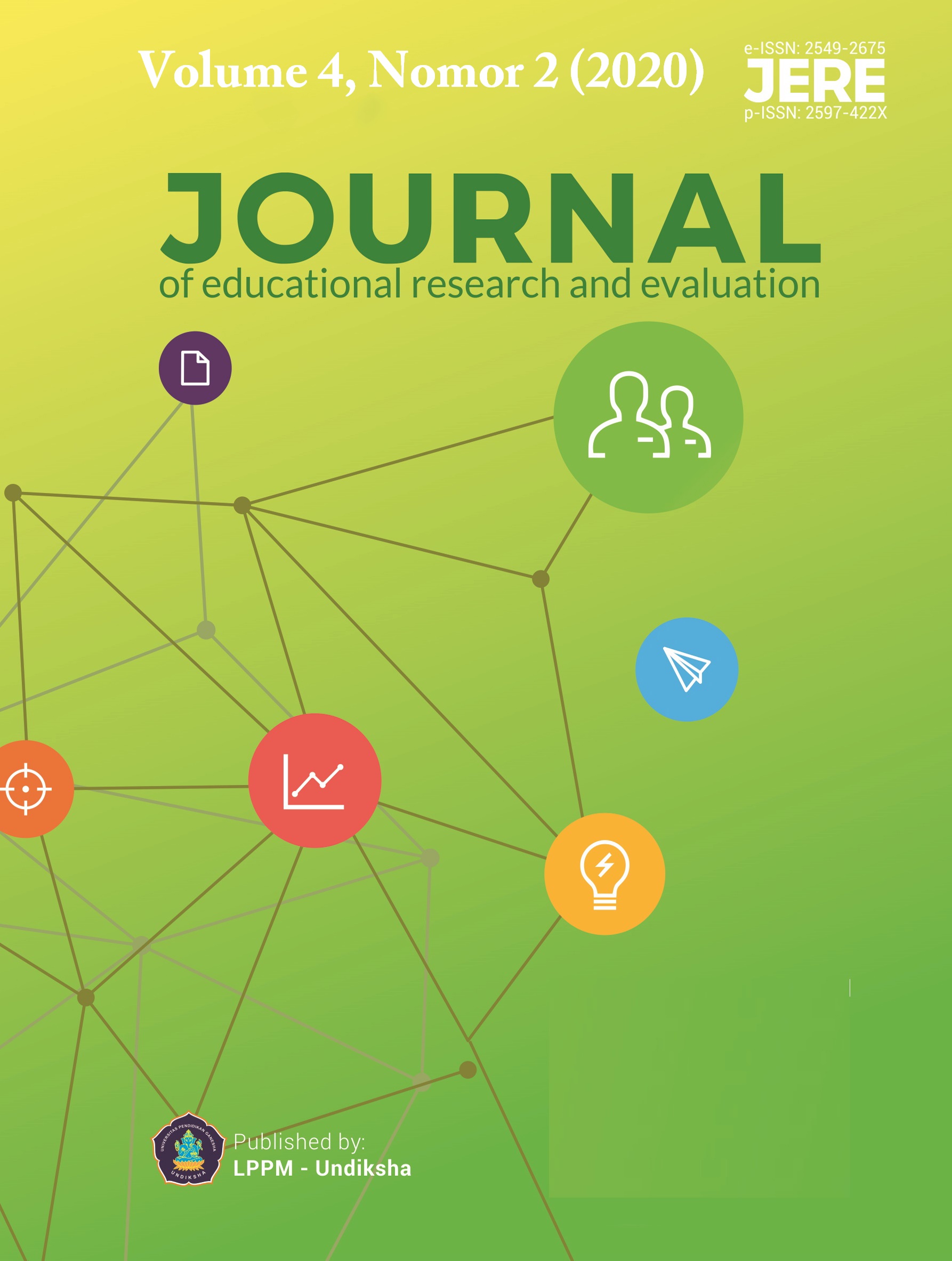The Use of Conversation Diary in Enhancing Students’ English Speaking Skill
DOI:
https://doi.org/10.23887/jere.v4i2.24720Keywords:
enhance, speaking, diary, mediaAbstract
This research describes the use of Conversation Diary as a strategy in increasing students’ English speaking skill and discovers the decreasing of students’ anxiety in performing English speaking. This research is done in Classroom Action Research (CAR) within 2 cycles. Each of the cycle is started by assessing classroom problems, and continues with planning, acting, observing, and reflecting. Each cycle has four meetings to accomplish. The participants of this study were 30 students. They got Conversation Diary treatment during eight weeks. Test 1 and test 2 were conducted to get numerical data while interview, observation checklist, and questionnaire were used to get verbal data needed. The finding informed that cycle 1 failed. It was because most of students’ vocabulary and grammar understanding were still low, caused by length and frequency of time which was too short. On the other hand, from verbal information data, it is found that the students’ behaviour has changed. However, cycle 2 is still needed. Cycle 2 showed students’ behaviour were increased. The students’ score test 3 reached minimum score. In conclusion, this study proved that Conversation Diary could improve the students’ speaking skill better and help decreasing the students’ anxiety. With enough length of time, it would gain better result.
References
Aida, Y. (1994). Examination of Horwitz, Horwitz, and Cope's construct of foreign language anxiety: The case of students of Japanese. The modern language journal, 78(2), 155-168.
Alonso, A. C. (2011). Learning diaries to Foster learner autonomy in mixed-ability groups. Tejuelo: Didáctica de la Lengua y la Literatura. Educación(11), 47-63.
Amir, H. (Producer). (2013). Speaking skills. Retrieved from https://www.slideshare.net/zeal_eagle/speaking-skills-24884424
Ary, D., Jacobs, L. C., & Razavieh, A. (2010). Introduction to research in education 8th edition, Wardswoth Cengage Learning. Canada: Nelson Education Ltd Exotic Classic.
Azizifar, A., Faryadian, E., & Gowhary, H. (2014). The effect of anxiety on Iranian EFL learners' speaking skill. International Research Journal of Applied and Basic Sciences, 8(10), 1747-1754.
Barrett, K. C., Morgan, G. A., Leech, N. L., & Gloeckner, G. W. (2011). IBM SPSS for introductory statistics: Use and interpretation. New York: Routledge.
Brown, H. D. (2000). Principles of language learning and teaching. In. New York: Pearson Education.
Creswell, J. W. (2012). Educational research : Planning, conducting, and evaluating quantitative and qualitative research. Boston: Pearson.
El-Koumy, A. S. (Producer). (1998). Effect of Dialogue Journal Writing on EFLStudents' Speaking Skill. Retrieved from https://files.eric.ed.gov/fulltext/ED502908.pdf
Faucette, P. (2001). A pedagogical perspective on communication strategies: Benefits of training and an analysis of English language teaching materials. University of Hawai'I Second Langauge Studies Paper 19 (2).
Fraenkel, J. R., Wallen, N. E., & Hyun, H. H. (1993). How to design and evaluate research in education. New York: McGraw-Hill
Fromkin, V., Rodman, R., & Hyams, N. (2011). An introduction to language: Cengage Learning.
Goh, C. C. M. (2007). Teaching speaking in the language classroom: SEAMEO Regional Language Centre Singapore.
Harris, D. P. (1969). Testing English as a Second Language. New York: McGraw-Hill.
Horwitz, E. (2001). Language anxiety and achievement. Annual review of applied linguistics, 21, 112-126.
Horwitz, E. K., Horwitz, M. B., & Cope, J. (1986). Foreign language classroom anxiety. The modern language journal, 70(2), 125-132.
Huberty, T. J. (2009). Test and performance anxiety. Principal leadership, 10(1), 12-16.
Hughes, R. (2011). Teaching and Researching: Speaking. Great Britain: Pearson Education.
Juan, E. U., & Flor, A. M. (2006). Current trends in the development and teaching of the four language skills. New York: Walter de Gruyter.
Kemmis, S., McTaggart, R., & Nixon, R. (2014). Introducing critical participatory action research. In The action research planner (pp. 1-31): Springer.
Koshy, V. (2005). Action research for improving practice: A practical guide. London: Sage.
Kreutzer, M., & Ivelich, A. (2017). Fix Your Bad English in 50 minutes!. New York. Retrieved from https://www.youtube.com/watch?v=OI2wQwtzHX0&t=135s
Latief, M. A. (2012). Research methods on language learning: An introduction. Malang: Universitas Negeri Malang Press.
MacIntyre, P. D., & Gardner, R. C. (1991). Investigating language class anxiety using the focused essay technique. The Modern Language Journal, 75(3), 296-304.
Nakatani, Y. (2005a). The Effects of Awareness-Raising Training on Oral Comunication Strategy Use. The modern language journal, 89.
Nakatani, Y. (2005b). The effects of awareness‐raising training on oral communication strategy use. The modern language journal, 89(1), 76-91.
Oxford, R. L., Lavine, R. Z., Felkins, G., Hollaway, M. E., & Saleh, A. (1996). Telling their stories: Language students use diaries and recollection. In R. L. Oxford (Ed.), Language learning strategies around the world: Cross-cultural perspectives (pp. 19-34). Honolulu.
Peterson, S. S. (Producer). (2000). Pronunciation Learning Strategies: A First Look. Retrieved from https://files.eric.ed.gov/fulltext/ED450599.pdf
Richards, J. C., & Schmidt, R. W. (2013). Longman dictionary of language teaching and applied linguistics. London: Routledge.
Sato, K. (Producer). (2003). Improving Our Students' Speaking Skills: Using Selective
Error Correction and Group Work To Reduce Anxiety andEncourage Real Communication. Retrieved from https://files.eric.ed.gov/fulltext/ED475518.pdf
Shumin, K. (2002). Developing Adult EFL Students’ Speaking Abilities In Methodology in Language Teaching: An Anthology of Current Practices. Cambridge: Cambridge University Press.
Skehan, P. (1996). Second language acquisition research and task-based instruction. In J. Willis & D. Willis (Eds.), Challenge and change in language teaching. Oxford: Heinemann
Tsuda, S. (2003). Attitudes toward English language learning in higher education in Japan (2): Raising awareness of the notion of global English. Intercultural Communication Studies, 12(3), 61-75.
Wang, Z. (2014). Developing Accuracy and Fluency in Spoken English of Chinese EFL Learners. English Language Teaching, 7(2), 110-118.
Woodrow, L. (2006). Anxiety and speaking English as a second language. RELC journal, 37(3), 308-328.
Yule, G. (2016). The study of language. Cambridge: Cambridge university press.
Zhang, Y., & Jia, G. (2006). Anxiety in foreign language classroom. CELEA Journal, 29(6), 96-103.
Downloads
Published
How to Cite
Issue
Section
License
Authors who publish with the Journal of Evaluation and Research in Education (JERE) agree to the following terms:
- Authors retain copyright and grant the journal the right of first publication with the work simultaneously licensed under a Creative Commons Attribution License (CC BY-SA 4.0) that allows others to share the work with an acknowledgment of the work's authorship and initial publication in this journal.
- Authors are able to enter into separate, additional contractual arrangements for the non-exclusive distribution of the journal's published version of the work (e.g., post it to an institutional repository or publish it in a book), with an acknowledgment of its initial publication in this journal.
- Authors are permitted and encouraged to post their work online (e.g., in institutional repositories or on their website) prior to and during the submission process, as it can lead to productive exchanges, as well as earlier and greater citation of published work. (See The Effect of Open Access)











